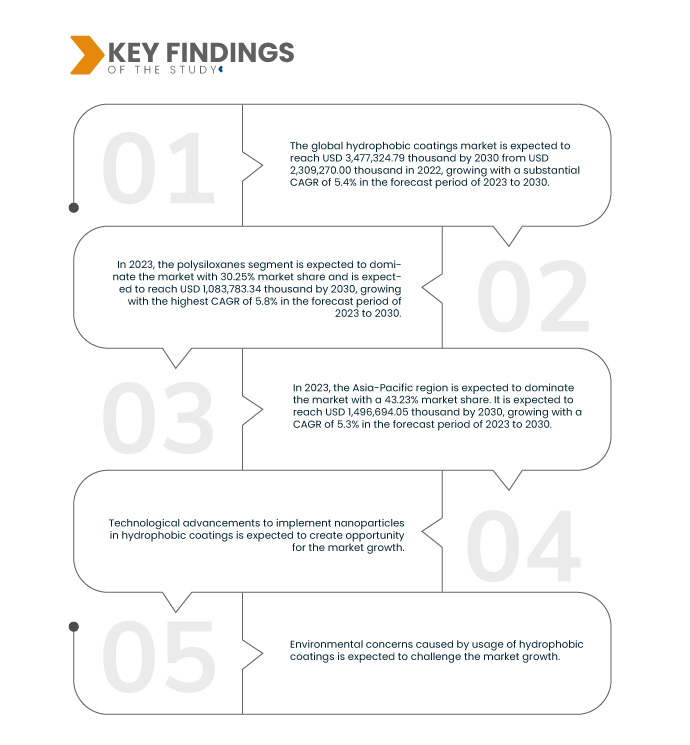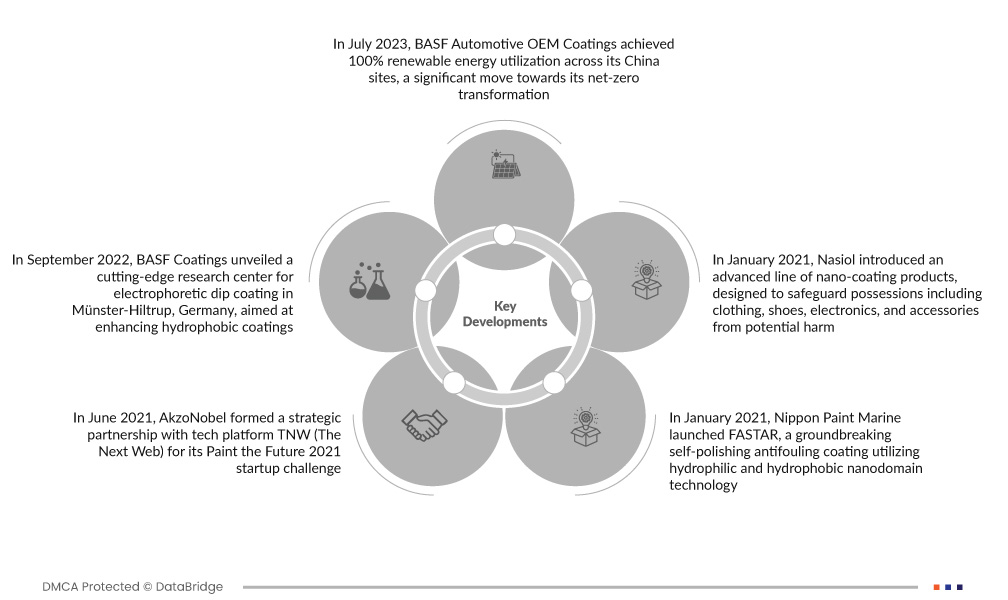The demand for anti-corrosive coatings in marine structures is a pivotal driver for the growth of the market. Marine structures, including ships, offshore platforms, ports, and coastal infrastructure, are constantly exposed to harsh environmental conditions such as saltwater, humidity, and abrasive forces. These conditions accelerate corrosion, posing significant maintenance and durability challenges. The application of anti-corrosive coatings is essential to mitigate these challenges and extend the service life of marine structures.
Access Full Report @ https://www.databridgemarketresearch.com/fr/reports/global-hydrophobic-coatings-market
Data Bridge Market Research analyzes that the Global Hydrophobic Coatings Market is expected to reach USD 3,477,324.79 thousand by 2030 from USD 2,309,270.00 thousand in 2022, growing with a substantial CAGR of 5.4% in the forecast period of 2023 to 2030. An increase in the utilization of hydrophobic coatings in guidewires is expected to drive market growth.
Key Findings of the Study
Usage of Hydrophobic Coatings in the Automotive and Aerospace Sector
Hydrophobic coatings find extensive usage in both the automotive and aerospace sectors, where their unique properties offer significant advantages. In the automotive sector, hydrophobic coatings are applied to various exterior and interior components, such as windshields, windows, paint, and upholstery. These coatings repel water and prevent moisture accumulation on surfaces, improving visibility, reducing the need for constant cleaning, and enhancing overall safety. In addition, hydrophobic coatings on automotive surfaces help minimize corrosion and the adhesion of dirt, grime, and contaminants, thus extending the lifespan of vehicle exteriors. In the aerospace sector, hydrophobic coatings are employed in aircraft exteriors and interiors to ensure optimal performance and passenger comfort. Aircraft surfaces treated with hydrophobic coatings experience reduced ice accumulation, leading to enhanced aerodynamics and fuel efficiency.
These coatings also minimize water retention on aircraft surfaces, which can contribute to weight reduction during flight, subsequently improving overall fuel consumption. In the cabin, hydrophobic coatings applied to windows and other surfaces help prevent condensation and fogging, enhancing passenger visibility and experience.
Report Scope and Market Segmentation
|
Report Metric
|
Details
|
|
Forecast Period
|
2023 to 2030
|
|
Base Year
|
2022
|
|
Historic Year
|
2021 (Customizable to 2015-2020)
|
|
Quantitative Units
|
Revenue in USD Thousand
|
|
Segments Covered
|
Product (Polysiloxanes, Fluoropolymers, Fluoro-Alkylsilanes, Titanium Dioxide, and Others), Substrate Type (Metal, Glass, Polymer, Ceramics, Concrete, and Textiles), Coating Layer (Single Layer and Multi-Layer), Application Method (Dip Coating, Brushing, Roll Coating, Spraying, and Others), Function (Anti-Corrosion, Anti-Microbial, Anti-Fouling, Anti-Icing/Wetting, Self-Cleaning, and Others), End-User (Automotive, Electronics, Building & Construction, Marine, Textiles, Healthcare, Aerospace, Oil & Gas, Food & Beverages, and Others)
|
|
Countries Covered
|
China, India, Japan, South Korea, Australia And New Zealand, Indonesia, Singapore, Malaysia, Thailand, Philippines, Rest Of Asia-Pacific, Germany, U.K., France, Italy, Spain, Netherlands, Belgium, Russia, Turkey, Switzerland, Rest Of Europe, U.S., Canada, Mexico, Brazil, Argentina, Rest Of South America, United Arab Emirates, Saudi Arabia, South Africa, Egypt, Israel, and Rest Of Middle East And Africa
|
|
Market Players Covered
|
PPG Industries, Inc. (U.S.), BASF SE (Germany), Akzo Nobel N.V. (Netherlands), 3M (U.S.), Nippon Paint Holdings Co., Ltd. (Japan), Aculon (U.S.), Advanced Nanotech Lab (India), ALLEGIANCE NANOSOLUTIONS (U.S.), Artekya Teknoloji (Turkey), CYTONIX, LLC (U.S.), Lotus Leaf Coatings, Inc. (U.S.), Nanokote (Australia), NEI Corporation (U.S.), and NOANIX (South Korea) among others
|
|
Data Points Covered in the Report
|
In addition to the insights on market scenarios such as market value, growth rate, segmentation, geographical coverage, and major players, the market reports curated by the Data Bridge Market Research also include depth expert analysis, pricing analysis, and regulatory framework
|
Segment Analysis
The global hydrophobic coatings market is segmented into six notable segments on the basis of product, substrate type, coating layer, application method, function, and end-user.
- On the basis of product, the market is segmented into polysiloxanes, fluoropolymers, fluoro-alkylsilanes, titanium dioxide, and others.
In 2023, polysiloxanes segment is expected to dominate the global hydrophobic coatings market
In 2023, the polysiloxanes segment is expected to dominate the market with a 30.25% market share, due to its extreme water-repellence properties which boosts its demand during the forecast period.
- On the basis of substrate type, the market is segmented into metal, glass, polymer, ceramics, concrete, and textiles.
In 2023, metal segment is expected to dominate the global hydrophobic coatings market.
In 2023, the metal segment is expected to dominate the market with a 33.89% market share, due to its corrosion resistance property which boosts its demand during the forecast period.
- On the basis of coating layer, the market is segmented into single layer and multi-layer. In 2023, the multi-layer segment is expected to dominate the market with a 67.93% market share.
- On the basis of application method, the market is segmented into dip coating, brushing, roll coating, spraying, and others. In 2023, the spraying segment is expected to dominate the market with a 39.12% market share.
- On the basis of function, the market is segmented into anti-corrosion, anti-microbial, anti-fouling, anti-icing/wetting, self-cleaning, and others. In 2023, the anti-corrosion segment is expected to dominate the market with a 31.00% market share.
- On the basis of end-user, the market is segmented into automotive, electronics, building & construction, marine, textiles, healthcare, aerospace, oil & gas, food & beverages, and others. In 2023, the marine segment is expected to dominate the market with a 17.53% market share.
Major Players
Data Bridge Market Research recognizes the following companies as the major market players operating in the market that include PPG Industries, Inc. (U.S.), BASF SE (Germany), Akzo Nobel N.V. (Netherlands), 3M (U.S.), Nippon Paint Holdings Co., Ltd. (Japan), Aculon (U.S.), Advanced Nanotech Lab (India), ALLEGIANCE NANOSOLUTIONS (U.S.), Artekya Teknoloji (Turkey), CYTONIX, LLC (U.S.), Lotus Leaf Coatings, Inc. (U.S.), Nanokote (Australia), NEI Corporation (U.S.), and NOANIX (South Korea) among others.
Market Development
- In July 2023, BASF Automotive OEM Coatings achieved 100% renewable energy utilization across its China sites, a significant move towards its net-zero transformation. This initiative, through a mix of Renewable Direct Power Purchases, international renewable energy certificates, and other strategies, is set to lower carbon emissions by around 19,000 tons by the end of 2023. The advancement highlights BASF's dedication to eco-friendly solutions and resonates with the hydrophobic coatings market, showcasing its efforts to minimize its carbon footprint and meet customer sustainability expectations.
- In September 2022, BASF Coatings unveiled a cutting-edge research center for electrophoretic dip coating in Münster-Hiltrup, Germany, aimed at enhancing hydrophobic coatings. The facility prioritizes safety and efficiency, enabling the simulation of customer processes and paint systems. The center focuses on CathoGuard 800 e-coat technology, known for protecting car surfaces against corrosion while being environmentally friendly with low solvent content and reduced wastewater. This innovation bolsters BASF's position in the hydrophobic coatings market, offering advanced solutions for car body protection.
- In June 2021, AkzoNobel formed a strategic partnership with tech platform TNW (The Next Web) for its Paint the Future 2021 startup challenge. This collaboration aims to harness the power of open innovation by connecting with tech innovators. By teaming up with TNW, known for its expertise in the tech industry, AkzoNobel seeks to attract high-quality submissions that align with its sustainable business goals. This initiative builds upon AkzoNobel's successful Paint the Future ecosystem, fostering collaboration between startups, academia, research institutes, and suppliers to drive innovation in paints and coatings.
- In January 2021, Nippon Paint Marine launched FASTAR, a groundbreaking self-polishing antifouling coating utilizing hydrophilic and hydrophobic nanodomain technology. This next-gen marine solution addresses the challenges posed by shifting seawater temperatures and varying ship operations due to market changes and environmental concerns. With a track record of innovative coatings, Nippon Paint Marine continues to drive eco-friendly advancements in the maritime industry, aiming for efficient and responsible vessel operations..
- In January 2021, Nasiol introduced an advanced line of nano-coating products, designed to safeguard possessions including clothing, shoes, electronics, and accessories from potential harm. This launch positions Nasiol as a leader in protective solutions
Regional Analysis
Geographically, the countries covered in the global hydrophobic coatings market are China, India, Japan, South Korea, Australia And New Zealand, Indonesia, Singapore, Malaysia, Thailand, Philippines, Rest Of Asia-Pacific, Germany, U.K., France, Italy, Spain, Netherlands, Belgium, Russia, Turkey, Switzerland, Rest Of Europe, U.S., Canada, Mexico, Brazil, Argentina, Rest Of South America, United Arab Emirates, Saudi Arabia, South Africa, Egypt, Israel, and Rest Of Middle East And Africa.
As per Data Bridge Market Research analysis:
Asia-Pacific is the dominant region in the market.
Asia-Pacific region is expected to dominate the market due to the growth of the automotive and aerospace industry. These coatings provide water-repellent properties, enhancing the performance and durability of aircraft and automobile surfaces. As these industries continue to expand in the region, the need for advanced protective solutions like hydrophobic coatings is driving market growth.
Europe is estimated to be the fastest-growing region in the market during the forecast period 2023 - 2030.
Europe is expected to grow with the highest the global hydrophobic coatings market due to increased demand for water-repellent solutions across industries, such as automotive, electronics, and construction, to enhance product performance and durability.
For more detailed information about the global hydrophobic coatings market report, click here – https://www.databridgemarketresearch.com/fr/reports/global-hydrophobic-coatings-market














